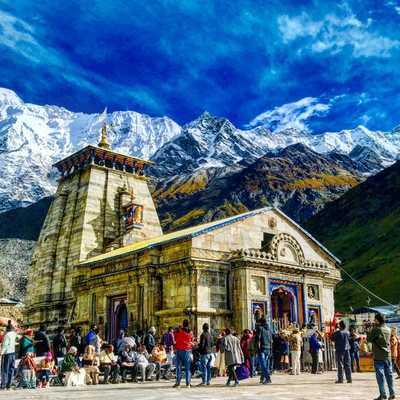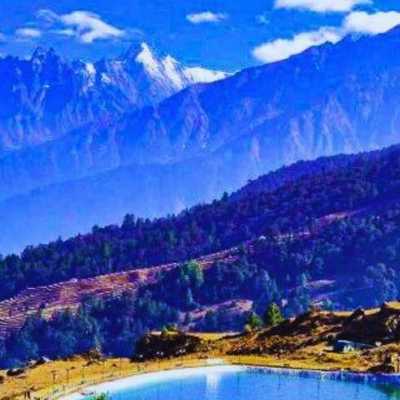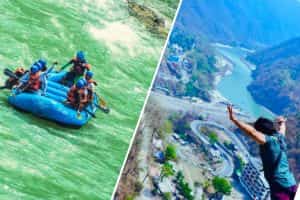Kedarnath is a revered Hindu pilgrimage site nestled high in the Garhwal Himalayas of Uttarakhand, India, at an altitude of approximately 3,583 meters (11,755 ft). It is prominently known for the ancient Kedarnath Temple, dedicated to Lord Shiva, and is one of the twelve Jyotirlingas, making it a cornerstone of the Char Dham Yatra and Panch Kedar pilgrimage circuits. Surrounded by majestic snow-capped peaks like Kedarnath Mountain and the Kedar Dome, and situated on the banks of the Mandakini River, the location offers breathtaking natural beauty.
| Location | Rudraprayag, Uttarakhand, India |
|---|---|
| Elevation | 3,583 meters (11,755 ft) |
| Open | May to October |
| Closed | November to April |
| Nearest Railway Station | Yognagri Rishikesh/ Haridwar/ Dehradun |
| Nearest Airport | Jolly Grant Airport, Dehrdaun (DED) |
| Motorable Road | Upto Sonprayag |
| Change Of Cab | Sonprayag to Gaurikund in local jeep (05 KM) |
| Trek Length | 22 KM (Gaurikund to Kedarnath Temple) |
| Rivers You Explore | Ganges, Bhagirathi, Alaknanda, Mandakini, and Songanga |
| Places to see | Rishikesh, Devprayag Sangam, Dhari Devi Temple, Rudraprayag Sangam, Sonprayag Sangam, Kedarnath Dham, Bheem Shila, and Bhairon Ghati |

Discover Barkot, Uttarkashi, Guptkashi, Yamunotri, Gangorti, Kedarnath, Chopta, Badrinath, Rudraprayag
₹30,400 PP*4 PAX

Discover Haridwar Barkot, Uttarkashi, Guptkashi, Yamunotri, Gangorti, Kedarnath, Chopta, Badrinath, Rudraprayag
₹33,500 PP*4 PAX

Discover Barkot, Uttarkashi, Guptkashi, Yamunotri, Gangorti, Kedarnath, Chopta, Tungnath, Badrinath, Rudraprayag
₹36,300 PP*4 PAX

Discover Haridwar Barkot, Uttarkashi, Guptkashi, Kedarnath, Chopta, Badrinath, Rudraprayag, Auli, Rishikesh
₹36,300 PP*4 PAX

Discover Haridwar Barkot, Uttarkashi, Guptkashi, Kedarnath, Chopta, Badrinath, Rudraprayag, Auli, Rishikesh
₹39,700 PP*4 PAX

Discover Haridwar Barkot, Uttarkashi, Guptkashi, Kedarnath, Chopta, Badrinath, Rudraprayag, Rishikesh
₹39,300 PP*4 PAX

Discover Haridwar, Yamunotri, Gangorti, Kedarnath, Tunganth, Badrinath, Rishikesh
₹42,750 PP*4 PAX

Discover Haridwar, Yamunotri, Gangorti, Kedarnath, Badrinath, Auli, Rishikesh
₹42,750 PP*4 PAX

Discover Devprayag, Srinagar, Rudraprayag, Agastmuni, Ukhimath, Chopta, Tungnath, Gopeshwar, Joshimath, Auli, Nandprayag, Karnprayag, and Rishikesh
₹7,560 PP*4 PAX

Discover Rishikesh, Devprayag, Srinagar, Rudraprayag, Ukhimath, Guptkashi, Kedarnath, Chopta, Tungnath, Gopeshwar, Joshimath, Auli, Nandprayag, Karnprayag, and Haridwar.
₹23,760 PP*4 PAX

Get Dzire/Amaze/Zest in great condition with fuel, driver, toll, parking, and taxes.
Attractions covered: Devprayag Sangam, Dhari Devi Temple, and Rudraprayag Sangam.
🚕 Rishikesh To Sonprayag Drop @ 6000.00
🚕 Haridwar To Sonprayag Drop @ 7000.00
🚕 Dehradun To Sonprayag Drop @ 7000.00
🚕 03 Days Kedarnath Ex Rishikesh @ 13500.00
🚕 03 Days Kedarnath Ex Haridwar @ 15000.00
🚕 03 Days Kedarnath Ex Dehradun @ 15000.00
🚕 04 Days Kedarnath Ex Rishikesh @ 16000.00
🚕 04 Days Kedarnath Ex Haridwar @ 17000.00
🚕 04 Days Kedarnath Ex Dehradun @ 17000.00

Get Ertiga/Carens/XL6 in great condition with fuel, driver, toll, parking, and taxes.
Attractions covered: Devprayag Sangam, Dhari Devi Temple, and Rudraprayag Sangam.
🚕 Rishikesh To Sonprayag Drop @ 7000.00
🚕 Haridwar To Sonprayag Drop @ 8000.00
🚕 Dehradun To Sonprayag Drop @ 8000.00
🚕 03 Days Kedarnath Ex Rishikesh @ 16500.00
🚕 03 Days Kedarnath Ex Haridwar @ 18000.00
🚕 03 Days Kedarnath Ex Dehradun @ 18000.00
🚕 04 Days Kedarnath Ex Rishikesh @ 20000.00
🚕 04 Days Kedarnath Ex Haridwar @ 21000.00
🚕 04 Days Kedarnath Ex Dehradun @ 21000.00

Get Latest Innova Crysta cabs in great condition with fuel, driver, toll, parking, and taxes.
Attractions covered: Devprayag Sangam, Dhari Devi Temple, and Rudraprayag Sangam.
🚕 Rishikesh To Sonprayag Drop @ 8000.00
🚕 Haridwar To Sonprayag Drop @ 9000.00
🚕 Dehradun To Sonprayag Drop @ 9000.00
🚕 03 Days Kedarnath Ex Rishikesh @ 18000.00
🚕 03 Days Kedarnath Ex Haridwar @ 20000.00
🚕 03 Days Kedarnath Ex Dehradun @ 20000.00
🚕 04 Days Kedarnath Ex Rishikesh @ 24000.00
🚕 04 Days Kedarnath Ex Haridwar @ 26000.00
🚕 04 Days Kedarnath Ex Dehradun @ 26000.00

Get Newest Crysta Hycross cabs with fuel, driver, toll, parking, and taxes.
Attractions covered: Devprayag Sangam, Dhari Devi Temple, and Rudraprayag Sangam.
🚕 Rishikesh To Sonprayag Drop @ 9000.00
🚕 Haridwar To Sonprayag Drop @ 9500.00
🚕 Dehradun To Sonprayag Drop @ 10000.00
🚕 03 Days Kedarnath Ex Rishikesh @ 20000.00
🚕 03 Days Kedarnath Ex Haridwar @ 21000.00
🚕 03 Days Kedarnath Ex Dehradun @ 21000.00
🚕 04 Days Kedarnath Ex Rishikesh @ 25000.00
🚕 04 Days Kedarnath Ex Haridwar @ 27000.00
🚕 04 Days Kedarnath Ex Dehradun @ 27000.00

Get huge space 12 pax carrier Tempo Traveller cabs with fuel, driver, toll, parking, and taxes.
Attractions covered: Devprayag Sangam, Dhari Devi Temple, and Rudraprayag Sangam.
🚕 Rishikesh To Sonprayag Drop @ 14000.00
🚕 Haridwar To Sonprayag Drop @ 15000.00
🚕 Dehradun To Sonprayag Drop @ 15000.00
🚕 03 Days Kedarnath Ex Rishikesh @ 25000.00
🚕 03 Days Kedarnath Ex Haridwar @ 27000.00
🚕 03 Days Kedarnath Ex Dehradun @ 27000.00
🚕 04 Days Kedarnath Ex Rishikesh @ 34000.00
🚕 04 Days Kedarnath Ex Haridwar @ 36000.00
🚕 04 Days Kedarnath Ex Dehradun @ 36000.00

Get premium 16 pax carrier Tempo Traveller cabs with fuel, driver, toll, parking, and taxes.
Attractions covered: Devprayag Sangam, Dhari Devi Temple, and Rudraprayag Sangam.
🚕 Rishikesh To Sonprayag Drop @ 18000.00
🚕 Haridwar To Sonprayag Drop @ 20000.00
🚕 Dehradun To Sonprayag Drop @ 20000.00
🚕 03 Days Kedarnath Ex Rishikesh @ 36000.00
🚕 03 Days Kedarnath Ex Haridwar @ 38000.00
🚕 03 Days Kedarnath Ex Dehradun @ 38000.00
🚕 04 Days Kedarnath Ex Rishikesh @ 48000.00
🚕 04 Days Kedarnath Ex Haridwar @ 50000.00
🚕 04 Days Kedarnath Ex Dehradun @ 50000.00

Get premium 16 pax carrier Tempo Traveller cabs with fuel, driver, toll, parking, and taxes.
Attractions covered: Devprayag Sangam, Dhari Devi Temple, and Rudraprayag Sangam.
🚕 Rishikesh To Sonprayag Drop @ 18000.00
🚕 Haridwar To Sonprayag Drop @ 19000.00
🚕 Dehradun To Sonprayag Drop @ 20000.00
🚕 03 Days Kedarnath Ex Rishikesh @ 36000.00
🚕 03 Days Kedarnath Ex Haridwar @ 38000.00
🚕 03 Days Kedarnath Ex Dehradun @ 38000.00
🚕 04 Days Kedarnath Ex Rishikesh @ 48000.00
🚕 04 Days Kedarnath Ex Haridwar @ 50000.00
🚕 04 Days Kedarnath Ex Dehradun @ 50000.00

Get premium 16 pax carrier Tempo Traveller cabs with fuel, driver, toll, parking, and taxes.
Attractions covered: Devprayag Sangam, Dhari Devi Temple, and Rudraprayag Sangam.
🚕 Rishikesh To Sonprayag Drop @ 29000.00
🚕 Haridwar To Sonprayag Drop @ 32000.00
🚕 Dehradun To Sonprayag Drop @ 36000.00
🚕 03 Days Kedarnath Ex Rishikesh @ 51000.00
🚕 03 Days Kedarnath Ex Haridwar @ 56000.00
🚕 03 Days Kedarnath Ex Dehradun @ 58000.00
🚕 04 Days Kedarnath Ex Rishikesh @ 68000.00
🚕 04 Days Kedarnath Ex Haridwar @ 72000.00
🚕 04 Days Kedarnath Ex Dehradun @ 74000.00
📍 Get Great Packages, Hotels, Cabs, and Activities for Uttarakhand | Call Now: +91 9012 466 887

Indulge in Riverside/Jungle camping experience at Rishikesh or at Chopta.

Try thrilling Rafting/Bungee at Rishikesh with tranquil camping.

Get wildlife jeep safaris by nature lovers in the forests of Corbett/Rajaji.

Grab a bird's eye view of Himalayan ranges from Bhimtal/Dehradun.

Author: Lalit Mohan | Last Edited: 05 Sep, 2024
A valid Char Dham Yatra Registration is mandatory to embark on this spiritual oddyssey. Learn how to get a valid Char Dham Yatra registration yourself with this remarkable guide for Yatra registration.

Author: Lalit Mohan | Last Edited: 02 Aug, 2024
One who does this quadrilateral pilgrimage circuit with complete faith gets a place in heaven, it's said like that. As curious as it is, it also involves many considerations about a well-planned Himalayan Char Dham Yatra.

Author: Lalit Mohan | Last Edited: 10 Oct, 2024
There are really important things which you must be aware of before heading into this auspicious journey. These important points are made to ensure the safety and convenience of all the pilgrims.

Author: Lalit Mohan | Last Edited: 21 Sep, 2024
One who does this quadrilateral pilgrimage circuit with complete faith gets a place in heaven, it's said like that. As curious as it is, it also involves many considerations about a well-planned Himalayan Char Dham Yatra.